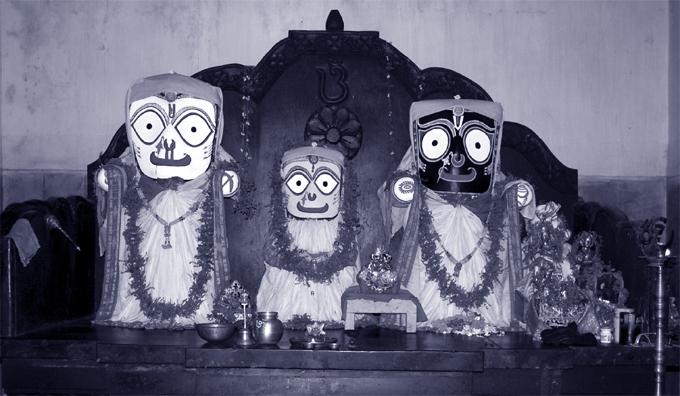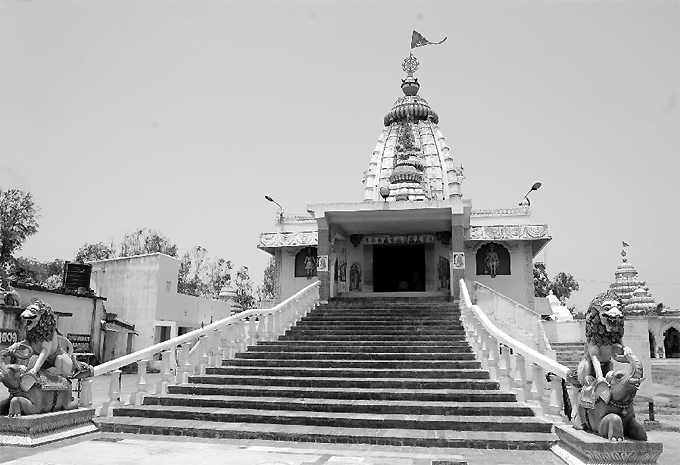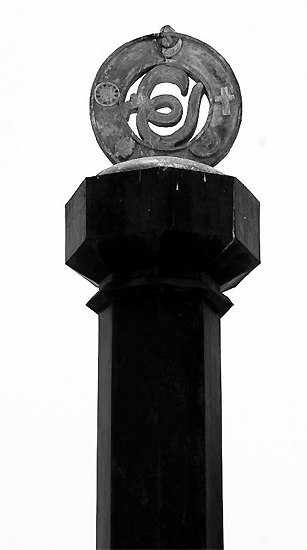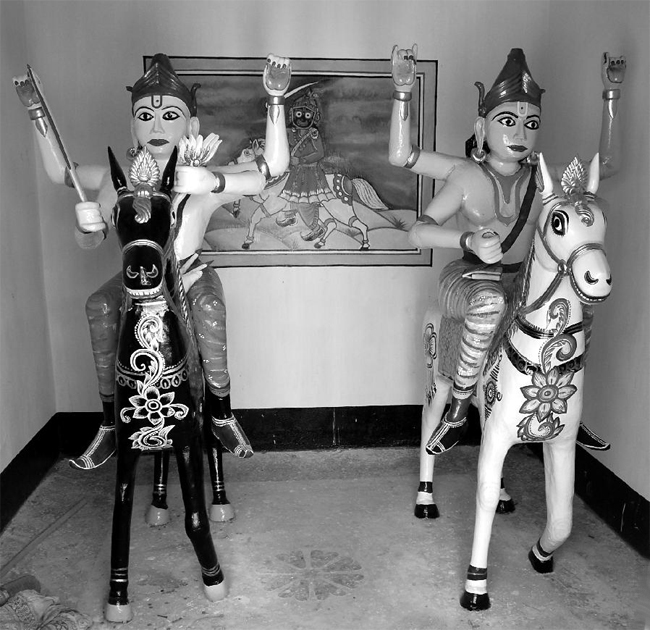BY: PRABHAT KUMAR NANDA
 Chaturdha Deities at Jagannath Temple, Paradip
Chaturdha Deities at Jagannath Temple, Paradip
Apr 24, 2011 — JAGATSINGHPUR, ORISSA (SUN) —
Paradip Port has specific importance from cultural and religious point
of view. As per the religious history of the area, famous monk, Parashar
was directed to meditate at the confluence point of river Mahanadi. Bay
of Bengal of today was popularly known as Kalinga Sagar from the period
Before Christ. There was dense mangrove forest around the confluence
point of river Mahanadi and Kalinga Sagar. The name of the area was
considered Paradip after the name of monk Parashar. In public parlance,
the name "Paradweep" was transferred to " Paradip".
According
to literary analysis there cannot be any meaning to "Paradip". In
ancient times the place was called as Paradweep, i.e., the island of
virtues or sacred importance. The meaning of the word "para" is
celestial and religious. Island is called "dweep" in Oriya. Hence, as
far as geographical situation is concerned, the port of Paradip is
situated as an island being covered by the Bay of Bengal, River Mahanadi
and River Atharbanki. As per the cultural heritage of the above island,
it is justified to name it as a sacred island, i.e. Paradweep. In
most of the ancient navigational charts prepared by English, Portuguese
and Dutch mariners the name of the Port has been reflected as Paradweep.
In the 21st Century Paradip Port is well known as an established major
sea port of the world. The Port has achieved the glory as a developing
deep sea port. [ ]
Before
the construction of a major port, Paradip was a famous religious place.
A number of local fishermen were using the River Atharbanki for
catching fish to meet their livelihood. The age old saying continues in
the area that fishermen could hear chanting of religious songs from the
dense forests of Paradip. Of many occasions fishermen in groups ventured
to enter into the forest to know about the source of such chanting, but
they failed to find out the particular place of such chanting of
religious songs. Hence, it was believed that such celestial continuous
chanting of religious verses were the act of God, fostering the age old
importance of the area. This area of Paradip is popularly known as
Madhuban.
Pandit
Padma Charan Tripathy, one of the ardent devotees of Goddess Sarala,
was directed in his dreams to select Madhuban for the construction of a
Jagannath Temple. As per the divine instructions through the dream, Sri
Padma Charan Tripathy with the assistance of Ananta Ojha, Gopal Baba,
Gopi Baba and other devotees, searched for the appropriate sight in the
dense forest of Madhuban. During the searching of the site, a wonderful
scene came to their sight. A falcon was attempting to attack a crow. The
crow could overpower the falcon and the falcon fled away, being afraid
of the crow. Observing this scene, Pt. Padma Charan Tripathy and his
associates could observe the holiness of the site. It was also observed
that a big cobra appeared under a Peepal tree and started hissing in
order to draw the attention of Pt. Tripathy and others. The site was
full of medicinal plants. Pt. Tripathy and others selected the site for
the construction of the Jagannath Temple.
Pt.
Padma Charan Tripathy organized religious function (yagna) from 25th
April to 19th of May 1974. Fifty-one Vedic scholars offered 35,000
offerings with ghee (ahuti). Prior to selection of the site in
the year 1969, devotee Ananta Ojha took the pivotal role in searching
out a neem tree for the construction of the idols of Lord Jagannath,
Lord Balabhadra, Goddess Subhadra and Sudarsana. A neem tree was
worshipped by the people of Paradip Gada, the area at a distance of 15
kilometers from Paradip. The neem tree was in the orchard of Sri
Narahari Sahoo at Paradip Gada. Devotee Ananta Ojha, Sanket Das and Gopi
Baba could observe the holy signs of Sankha, Chakra, Gada and Padma
(conch shell, wheel, bludgeon and lotus) on the trunk of the neem tree.
The tree was cut observing holy practices and was kept at Patrika Mahal
of Paradip. Gopal Baba constructed the idols within 15 days. In the
year 1967, the construction of the idols continued from Chitalagi
Amabasya to the day of Purnima.
In
the year 1972, an organization named Jagannath Samaj was formed and the
Endowment Commissioner of Govt. of Orissa included the temple in their
index in the year 1974. The index number was 6388/31 of 1972-73. On the
holy day of Akhyaya Trutiya, 1974, the Deities were installed in a
thatched house. Pt. Padma Charan Tripathy invited navi padma (spiritual soul) to enter into all the idols.
Sri
Premananda Tripathy, one of the celebrated Indian Administrative
Service Officers of Orissa, was appointed as the Chairman of Paradip
Port Trust and constructed a black top road from Paradip colony to the
temple site. Govt. of Orissa reserved 5 acres of land in the village
Sandhakuda for the use by Jagannath Temple Trust, for the construction
of the temple and other religious activities.
The
permanent temple of Lord Jagannath was constructed by the side of the
thatched house/temple in the year 1982. Mark Yaswant Rao, one of the
members of the Indian Administrative Service posted at Paradip, as the
Chairman of Paradip Port Trus, took the pivotal role for the
construction of the permanent temple. He was Christian by religion. He
permitted Jagannath Samaj to use the auditorium of Paradip Port Trust
named as Jayadev Sadan for the display of the films on payment of
nominal rent to the Port Trust. The funds generated from such film show
by selling tickets were utilized for the construction of the main
temple. The construction of the permanent temple were started on the
day of Akhaya Trutiya of 1984. Twenty-one scholars of Mukti Mandap Sabha
(the platform of scholars) of Puri under the guidance of Pt. Chintamani
Mishra organized Yagnya and the construction of the temple was
initiated.
The
construction of the temple took six years and it was completed in the
year 1990. Sri Prasanna Kumar Mishra, another member of Indian
Administrative Service posted as Chairman of Paradip Port Trust,
commissioned the temple on the sacred day of Akhaya Trutiya i.e. 27th
April 1990. All the Deities were brought to the new temple by procession
on that date. Prior to it, another saint, Swami Arupananda, organized a
week-long Yagnya from 21st to 27th April, 1990. Gajapati Maharaja of
Puri was present during the Yagnya.
After
the construction of the main temple in a two storeyed architectural
style, the construction of other temples i.e. Radha Krishna temple,
Biswanath temple, Sarala temple, Laxmi temple, Hanuman temple, Bimala
temple, and Kalki Ananta temple were initiated with the assistance of
different devotees.
Snana
Mandap, the platform for the bathing ceremony of the Deities; Ananda
Bazaar, platform for the community dining, and Bata Ganesh temple were
also constructed by different devotees. Different temples within the
premises of Jagannath temple were constructed by the united efforts of
different devotees and Paradip Port Authority.
 Sri Jagannath Temple, Paradip
Sri Jagannath Temple, Paradip
On
careful analysis of systems, practices and rites observed in the main
Jagannath Temple at Puri and at Paradip, a number of differences have
been noticed. Only orthodox Hindus are allowed to enter into the temple
of Lord Jagannath at Puri, whereas people of all religions, castes and
creeds are permitted to enter the temple of Lord Jagannath at Paradip.
It is beyond dispute that the name of Lord Jagannath symbolizes the Lord
of the Universe. Lord Jagannath is the saviour of all the creatures of
the world, people of all castes, creeds and religions. Since He is the
master of the world and considering the importance of the Name of the
Lord, nobody of the world should be denied to enter the temple of Lord
Jagannath.
The other name of Lord Jagannath is Patita Pavan. The down-trodden people of any society are known as patita.
The status of down-trodden is not limited to Hindus, Muslims or
Christians. Any human being suffering from distress under the sun is
considered down-trodden. Hence they are named as Patita. Since Lord
Jagannath is the saviour of all the down-trodden people of the world,
anybody interested to visit the temple should not be restricted or
denied considering His nomenclature.
 Sarba Dharma Samanwaya Sthambha
Sarba Dharma Samanwaya Sthambha
Not
only people of all religions are allowed to enter the temple of Lord
Jagannath at Paradip, but also symbols of important religions are
prominently displayed on the eight facets of a pillar named as Sarba
Dharma Samanwaya Sthambha, i.e. the Pillar of the Assimilation of All
Religions. As that of the presence of Aruna Stambha before the temple of
Lord Jagannath at Puri, Sarba Dharma Samanwaya Sthambha is commissioned
in front of 22 steps of Lord Jagannath Temple at Paradip. Symbols of
different religions are on the top of the pillar made of black granite
stone, an attraction for all devotees at Paradip. A circular figure has
been placed on the top of the pillar having the symbol of Om in the
middle. The symbol Om depicts Sanatana Dharma, i.e. the religion of
eternity. On the outer layer of the circle symbols of Islam,
Christianity, Zoroastrianism, Buddhism and Jainism have been decorated.
Hence in public, the temple of Lord Jagannath, Paradip, enunciates the
glory of the assimilation of all religions of the world into the cult of
Lord Jagannath.
 Kalki and Ananta in Kalki Temple, Paradip
Kalki and Ananta in Kalki Temple, Paradip
The
third differentiation which attracts the sight of devotees is the
presence of Lord Kalki and Ananta in the temple premises. It has been
established that the 10th incarnation of Lord Jagannath will be Kalki.
In Kali Yuga, Lord Jagannath will have the incarnation of Kalki to
eliminate vices and to establish the virtues in the human society. The
flag of blue and white colour has been placed on the Kalki Temple as per
the prediction in Malika, i.e. writing of saints for the future of the world. It is mentioned in Malikathat
when there will be the flying of a blue and white flag on the temple,
the action of the incarnation of Kalki will be initiated in the world.
In no other Jagannath temple of the world have the idols of Kalki and
Ananta been commissioned as per the verses of Malika.
A
number of religious signs are observed within a distance of 15
kilometers of the Paradip Port. Lokanath Temple at Paradip Gada depicts
the union of Hindu and Buddhist culture. A place named Udayabata has
been narrated in Malika as one of the important places of religious awakening. It is mentioned in the Malika that, near Udayabata, there will be emergence of sacred activities (lila). Devotees from all over the world will assemble near Udayabata and will engage themselves in the devotion of God.
Taking
all nearby places of Udayabata into consideration, Paradip Port is the
most important place and scholars have predicted that the future telling
of Malika about the emergence of the Kalki Avatara will start
from the Port of Paradip. Considering the facility of communication,
people from all over the world can safely and easily come to the Port of
Paradip by all modes of transport, i.e. road, air and sea. As a major
Port, large vessels requiring deep draft to sail can easily enter the
Port of Paradip carrying thousands of passengers.
The
popularization of the philosophy of Lord Jagannath is the main motto of
Jagannath Samaj. While other temple authorities have preferred to run
buses or commercial establishments for the generation of the fund for
the temple, Pt. Padma Charan Tripathy, the founder of the temple,
preferred for commissioning a printing press for the publication of
literature at low cost for distribution to the people of the world. The
Jagannath Temple Printing Press is continuing within the premises of the
temple.
Two
publications named Udayantu are published every year during the Car
festival (month of July) and Kartika Purnima (month of November), with
the compilation of essays contributed by scholars on different aspects
of Jagannath culture. Such publication of about 200 pages are made
available to the general public at the reduced price of Rs.5 each.
Articles in Oriya, Hindi and English are published in Udayantu,
facilitating readers of different languages to go through the articles.
The
age old blind belief, i.e. chanting of vulgar language by Dahukas
(persons directing the movement of the chariot during car festival) was
stopped at Paradip from the year 1994. Ladies of Paradip insisted on the
withdrawal of such practice in order to keep the glory of feminine
sentiment. A book consisting of 100 verses based on local culture was
published by Jagannath Samaj for the use by Dahukas in place of vulgar
enunciation. Such book as Rath Yatra Boli was sent to all the temples of
Lord Jagannath in India and abroad.
Paradip
Sakhyarata Samiti further published another book, Ho Bhagate,
consisting of verses based on local traditions of Orissa. At the request
of Paradip Sakhayarata Samiti, an organization established for the
promotion of social awareness, the Jagannath Trust authorities of Puri
issued an order in the year 1998 prohibiting the enunciation of vulgar
language in the chanting of Dahukas during the car festival.
The
culture of Lord Jagannath is based on universal brotherhood fostering
the dignity of humanity, which is known as Purosottama-tattva. Such
essence of the culture of Lord Jagannath has been put to practice in the
activities of the temple of Lord Jagannath at Paradip. The Port of
Paradip has secured a prominent position in the world map of trade and
commerce along with the promotion of the culture of Lord Jagannath and
international brotherhood.
Prabhat Kumar Nanda is the Vice President of Sri Jagannath Samaj, Paradip, Jagatsinghpur.
Source: Orissa Review.